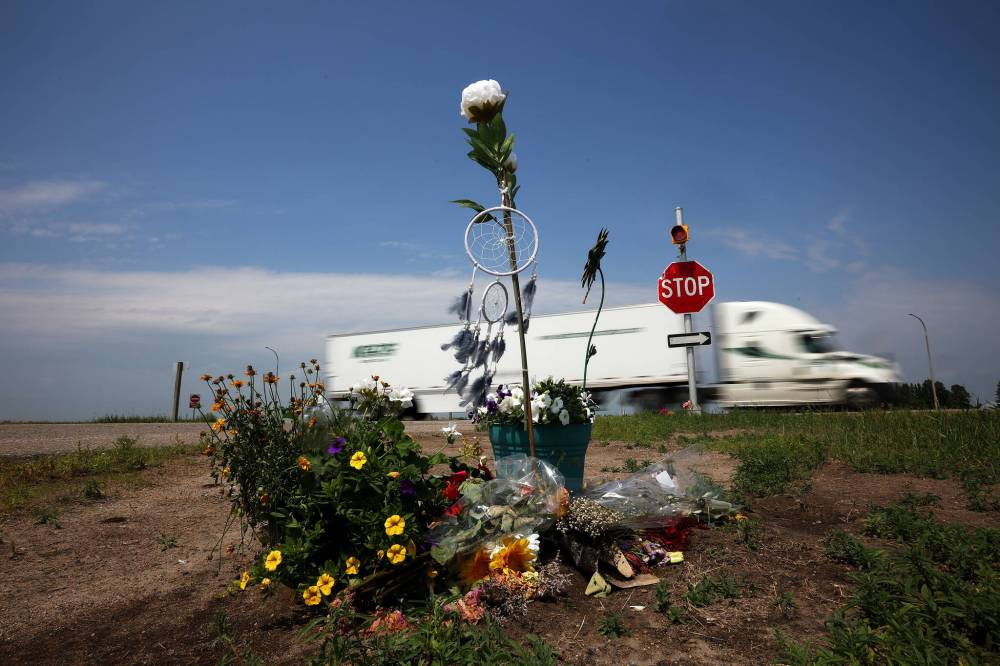Review the highway, not just the accident
Advertisement
Read this article for free:
or
Already have an account? Log in here »
To continue reading, please subscribe:
Monthly Digital Subscription
$0 for the first 4 weeks*
- Enjoy unlimited reading on winnipegfreepress.com
- Read the E-Edition, our digital replica newspaper
- Access News Break, our award-winning app
- Play interactive puzzles
*No charge for 4 weeks then price increases to the regular rate of $19.00 plus GST every four weeks. Offer available to new and qualified returning subscribers only. Cancel any time.
Monthly Digital Subscription
$4.75/week*
- Enjoy unlimited reading on winnipegfreepress.com
- Read the E-Edition, our digital replica newspaper
- Access News Break, our award-winning app
- Play interactive puzzles
*Billed as $19 plus GST every four weeks. Cancel any time.
To continue reading, please subscribe:
Add Free Press access to your Brandon Sun subscription for only an additional
$1 for the first 4 weeks*
*Your next subscription payment will increase by $1.00 and you will be charged $16.99 plus GST for four weeks. After four weeks, your payment will increase to $23.99 plus GST every four weeks.
Read unlimited articles for free today:
or
Already have an account? Log in here »
Hey there, time traveller!
This article was published 15/08/2024 (445 days ago), so information in it may no longer be current.
The wheels of progress, it has often been said, turn slowly.
The wheels of the vehicles on Manitoba’s highways, on the other hand, turn very, very quickly — creating speeds at which a mistake, a moment’s inattention or a motorway design flaw can have catastrophic consequences for those who travel on the province’s high-speed thoroughfares.
That contradiction raises questions about the manner in which highway accidents are investigated in Manitoba and, more broadly, Canada, and about the apparent lack of oversight when such investigations are carried out. The result, critics say, is a system in which investigations of mass-fatality accidents such as the one that occurred a year ago on the Trans-Canada Highway near Carberry seldom, if ever, result in decisive action aimed at preventing future catastrophic occurrences of a similar nature.

TIM SMITH / THE BRANDON SUN FILES
Memorial at the Carberry accident scene.
“We are too slow to make progress. Progress will happen, but we’re too slow to make recommendations, make progress and learn from these experiences,” said Ahmed Shalaby, a professor of civil engineering at the University of Manitoba whose specialty is road construction.
On June 15, 2023, a Handi-Transit bus carrying seniors from the Dauphin area on a day trip to a casino south of Carberry crossed Highway 1 into the path of an oncoming semi-trailer truck. The resulting collision claimed the lives of 17 of the bus’s passengers and left another eight seriously injured.
In Canada, the task of investigating mass-casualty highway accidents, such as this one or the 2018 accident involving the Humboldt Broncos’ team bus, is left to local law-enforcement — in both cases, the RCMP. In addition to determining whether criminal charges are warranted, such investigations must also include an assessment of vehicle, infrastructure and regulatory factors that may have contributed to the accident.
The process here is markedly different from that in the United States, where the interstate highway system is federally funded and maintained and a federal agency — the National Transportation Safety Board — is dispatched immediately to mass-casualty accident scenes. The investigative focus of a police service such as the RCMP is understandably on determining the cause of an accident and whether there was any wrongdoing involved, meaning more technical aspects of investigation might not be addressed in a sufficiently timely manner.
The NTSB’s more robust mandate includes gathering information from law enforcement, but also the examination of factors such as road design, vehicle standards and more, and seeking outside expertise from the likes of industry experts and manufacturers. Such consultations can result in affected parties making immediate improvements rather than waiting for NTSB recommendations to be made public.
Canada — where funding and maintenance of the “national” highway system left to cash-strapped provincial governments — does have a national transportation watchdog, the Transportation Safety Board. But its investigations are, for jurisdictional reasons that could best be described as baffling, limited to incidents involving rail, sea and air transport. It only intervenes in highway-accident investigations when a train or rail infrastructure is involved.
The RCMP’s investigation of the Carberry crash resulted, a year later, in a determination that no charges would be laid, largely because police were unable to interview the bus driver, who sustained a major brain injury in the crash. It was only after a provincially-ordered independent audit that a $12-million commitment was made for structural improvements for the heavily traveled intersection.
The process is unnecessarily cumbersome, and the figurative distance between one highway tragedy and the prevention of another remains unacceptably long.
When it comes to the safety of those who travel on its highways, Canada needs a transportation oversight agency whose mandate includes ensuring the wheels of progress turn with all due haste.




